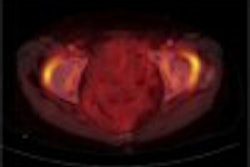CHICAGO - Accurate tumor staging is critical for patient management in clinical oncology. Research conducted by a team from Essen, Germany, suggests stage-adapted therapy – tumor staging (T), lymph node metastasis staging (N), and distant metastasis staging (M) – may benefit by the use of a mix of modalities.
Dr. Gerald Antoch, from the department of radiology at the University Hospital of Essen, presented the results of a study performed to compare the diagnostic accuracy of whole-body dual-modality PET/CT with whole-body MRI for the staging of cancer at the RSNA 2003 on Tuesday.
The researchers conducted imaging studies with PET/CT and MRI on patients with different malignant diseases to assess tumor staging. The studies all covered an axial field of view from the head to the upper thighs, said Antoch
The team imaged 60 patients using a dual-modality PET/CT (Biograph, Siemens Medical Solutions). PET imaging was performed one hour after the administration of 18-FDG and both intravenous and oral contrast agents were used in the diagnostic CT portion of the scan, he said.
MRI imaging was conducted on a 1.5 T scanner (Sonata, Siemens Medical Solutions). Unenhanced T1- and T2-weighted studies of the liver and thorax as well as contrast-enhanced whole-body T1 coverage was conducted by the team. PET/CT and MRI data sets were evaluated by different reader teams who were blinded to the results of the other imaging procedure, reported Antoch.
The researchers used histological results and clinical follow-up (mean, 199 days, +/-68) as their standards of reference.
“We limited our whole-body modality-to-modality comparison of accurate T-staging with PET/CT and MRI to 47 patients whose tumor stage was histologically verified,” noted Antoch. The group found that the T-stage was accurately determined in 41 of 47 patients (87%) with PET/CT and in 28 of 47 patients with MRI (60%).
PET/CT accurately staged lymph node status in 92 of 99 patients (93%) while MRI had a correct N-status in 82 of 99 patients (83%), according to the researchers. The M-stage was correctly determined in 91 of 99 patients (92%) with PET/CT and in 90 of 99 patients (91%) with MRI, said Antoch.
However, when the researchers looked at specific sites of carcinoma, both MR and PET/CT showed staging strengths and weaknesses. Antoch reported that PET/CT was superior in the staging of pulmonary metastases with sensitivity and specificity both at 96%, compared with MRI’s 89% and 81%.
Although PET/CT showed strong numbers for staging liver metastases, a sensitivity and specificity of 90% and 98%, MRI was more accurate with a sensitivity of 100% and a specificity of 97%. Bone metastases were also better staged with MRI, with PET/CT demonstrating a sensitivity of 75% and a specificity of 97%, while MRI showed an 83% sensitivity and a 96% specificity, he said.
“When it comes to whole-body imaging for the purposes of determining the T and N stage of tumors, PET/CT demonstrates better sensitivity and specificity than MRI. However, for certain metastases, such as those in the liver and bone, MRI is the superior imaging tool. On the basis of our results, we believe that PET/CT is ready to be used as a first-line tool for oncologic staging,” said Antoch.
By Jonathan S.
Batchelor
AuntMinnie.com staff writer
December 3, 2003
Copyright © 2003 AuntMinnie.com




















